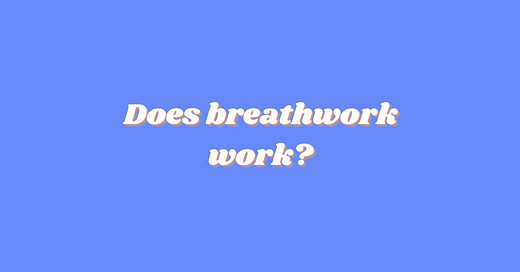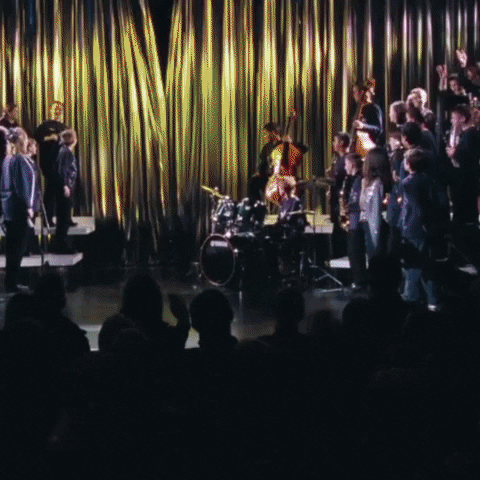Take a deep breath. Before wellness gave it a name, someone probably gave you this advice ahead of a big exam/scary presentation/the school nativity play.
Now, we know it as “breathwork” or “conscious breathing”. And from celebrities to CEOs, lots of people rave about its benefits. Including us—if you’ve followed us for a while, you’ll know that we often recommend breathing exercises as a way to manage your inner critic.
But is breathwork just a new age fad or is it a legit, science-backed tool? At Fuck Off Russell, you know we love to bring a healthy dose of research to the latest trends. So today, we’re going to put breathwork to the test.
What is breathwork?
First things first, what’s the difference between breathwork and just, well, breathing?
Basically, “breathwork” is a term that’s used to describe any techniques and practices that involve conscious control and manipulation of breathing patterns. This could be anything from taking that deep breath before your star turn in the school play, to a dedicated workshop.
The science behind breathwork
Although breathwork sometimes gets branded as “woo woo”, there is a growing body of research that supports the benefits of breathwork on our physical, mental, and emotional well-being.
Before we get into that, back to the foundations of breathing. You’ll already know that we breathe oxygen in and CO2 out. We do this without thinking all the time.
But that exchange of oxygen and CO2 has a big, complex impact on the rest of our bodily functions.
The main one you need to know about is that breathing influences our autonomic nervous system, which controls involuntary bodily functions. But contrary to the name, we do in fact have the power to regulate our autonomic nervous system.
Through certain activities, we can activate either our sympathetic nervous system (which controls our stress or “fight or flight” response) or our parasympathetic nervous system (which controls our rest and relaxation response).
Breathing techniques can help you stimulate the parasympathetic nervous system to calm down and reduce stress. Research shows that this lowers your heart rate, reduces blood pressure, and improves your overall physiological balance. If you make a habit of breathwork, it can even reduce symptoms of anxiety and depression, give you more mental clarity and alertness, and help regulate your emotions.
Reported benefits of breathwork
Stress reduction and relaxation
Improved mental clarity and focus
Better emotional self-regulation and resilience
Lowered heart rate and blood pressure
Increased lung capacity and oxygen exchange
Improved respiratory function (which can alleviate symptoms of asthma and other conditions)
Better cardiovascular health
Enhanced self-awareness and mindfulness
Reduced anxiety and depression symptoms
Boosted energy levels and vitality
Improved sleep quality
Stronger immune system
When to avoid breathwork
Sounds too good to be true, right? So, what’s the catch? Well, done right and at the right time, breathwork can be super effective.
However, it’s really important to practice breathwork safely. That’s because breathwork can be really powerful and lead to a big shift in your emotions.
If you’re feeling anxious
A common complaint about breathwork is that it can make anxiety worse. If you think about it, this makes sense for two reasons:
Hyperventilation is actually a form of deep breathing that stimulates your sympathetic nervous system, sending your body into panic mode. Quick, fast and deep breaths knock your oxygen to CO2 ratio off-balance, which makes you feel dizzy, faint and anxious.
While focusing on your breath can be extremely grounding, it can also be extremely difficult. For some, trying to return to the breath but feeling like you’re failing just triggers even more stress and dials up that inner critic.
If you’re feeling emotional
Likewise, breathwork can bring up intense emotions—you might find yourself feeling more vulnerable or even crying after a particularly powerful practice.
The key is choosing the right technique for the right mindset.
The rules of breathwork
Want to try out breathwork for yourself? Here are some principles to bear in mind.
Get to know the four ways to breathe
There are four different ways to breathe, and they have different effects on your nervous system.
Diaphragmatic: when you direct the breath towards the lower belly, while keeping your chest relatively still.
Effects: Relaxation.
Thoracic: when you direct the breath to the ribcage, but keep the belly still.
Effects: Increasing lung capacity and respiratory flow.
Clavicular: when you breathe from the top third of the lungs, raising the shoulders and collarbones, and holding the belly in (this is how a lot of us breathe most of the time).
Effects: Triggers your stress response.
Paradoxical: when you move your chest and belly inwards as you inhale, rather than expanding them.
Effects: Triggers your stress response (usually caused by considerable anxiety, shock or cold).
Breathe through your nose
Whether in passive (i.e. unconscious, everyday) breathing or conscious breathwork, breathing through the nose is the correct technique. This is because the nasal passage is designed to protect us from any impurities in the air.
Choose your breathing exercise wisely
One of the most widely known forms of breathwork is yogic breathing or Pranayama. If you’re curious about Pranayama, we recommend heading to your local yoga studio or checking out some videos online to learn how it’s done. Just make sure that when you’re trying out a new breathing exercise, you’re aware of its purpose and effects, so you know if you’re in the right mindset for it.
For example:
Sitali breath, where you curl your tongue like a straw and breathe in and out, cools the body, improves focus, and reduces anger and agitation.
Uijayi or victorious breath, where you constrict the back of the throat as you exhale, warms and energises the body, and calms the mind.
Pratiloma, where you alternate inhaling through each nostril and exhaling through both, calms and focuses the mind, and balances emotions.
As you can probably tell, breathwork is a hugely varied practice, with varied outcomes.
Our favourite breathwork studios
If you’d like some extra guidance, here are some breathwork practitioners and studios we love:
The Breath Space by Jamie Clements
Breathe with James by James Dowler
Breathwork: are you a fan?
Have you tried breathwork? How has it worked out for you? We’d love to chat in the comments.








